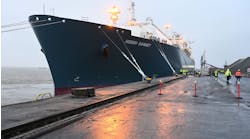Editor's note: This Rigs & Vessels section first appeared in the July-August 2022 issue of Offshore magazine. Click here to view the full issue.
By Bruce Beaubouef, Managing Editor
Field development driving deepwater rig activity offshore Brazil
Two key Equinor field development projects offshore Brazil are driving deepwater rig contracting activity, according to Evercore ISI’s July Offshore Rig Market Snapshot.
Recently, Valaris announced that it will be reactivating its DS-17 drillship for a new 540-day contract with Equinor for offshore Brazil. The $327-million contract value includes $86 million in upfront reimbursements for mobilization, reactivation, and upgrades.
The clean daily operating rate of $446,000/day includes managed pressure drilling services, ROV, casing running, slop treatment and cuttings handling. Preservation-stacked since April 2020, the seventh-generation drillship is expected to commence work on Equinor’s presalt Bacalhau field development project in mid-2023, joining Seadrill’s West Saturn.
The $8-billion Bacalhau project was sanctioned in June 2021 based on a $60/bbl oil price and has a $35/bbl breakeven. Schlumberger’s Subsea Integration Alliance was awarded the EPCI for the subsea production system (wellheads, controls, connection systems, and a completion workover riser) and pipelines (rigid risers, flowlines, and umbilicals), with Modec to provide an FPSO to produce 220,000 b/d of oil and 15 MMcm/d of natural gas from 19 wells starting in 2024.
Separately, Equinor awarded TechnipFMC a FEED study for the BM-C-33 presalt project offshore Brazil. The potential $1-billion plus award covers both the SPS (trees, manifolds, jumpers, rigid risers), SURF (flowlines, umbilicals, pipeline end terminations), subsea distribution and topside control equipment, and life-of-field services, with an FID as early as early 2023.
The report notes that three deepwater projects totaling nearly $14 billion in capex have been sanctioned year-to-date, while another 11 projects worth over $40 billion in capex could be approved later this year. “Meanwhile we expect contracting activity to continue to be dominated by jackups in the near term as 38 units are scheduled to roll including seven with Pemex and three with ONGC, versus a modest 13 floaters,” the report said.
Report: Asia-Pacific rig rates, demand rising
Rig activity in the Asia-Pacific (APAC) region has picked up markedly this year, according to Westwood Global Energy Group subsidiary RigLogix.
At the same time, various cold stacked and previously idle jackups in the region are being reactivated, though primarily for contracts in the Middle East.
Marketed utilization is now approaching 90% and could reach 95% by the end of the year.
There are currently three drillships in Southeast Asia, of which two are working. Transocean’s Dhirubhai Deepwater KG2 remains stacked, although it could depart the area for a contract elsewhere.
Rates for new drillship fixtures this year have been in the $220,000/d range, but RigLogix foresees the figure climbing toward $270,000, not including managed pressure drilling services, which can add $50,000 or more to the price tag.
Twelve semisubmersible rigs are in the region, seven in Southeast Asia with four working; however, only two have contracts that extend beyond 2022. Three new semi contracts have been signed this year, with dayrates still below $200,000.
All five semisubmersibles off Australia are working, with one due to become idle this month. Three have commitments stretching into 2024.
Of the three new semi contracts signed this year, the highest commanded $379,000/day, up from the previous high of $265,000/day.
As for the APAC jackup picture, of the 45 marketed rigs in Southeast Asia that are contracted or committed, six are destined for Saudi Arabia, with another four newbuilds set to join them there.
By year-end 2022 or early 2023, 15 jackups will have departed Southeast Asia for contracts with Saudi Aramco, RigLogix claims.
Borr Drilling’s Saga recently secured a four-year deal at a rate reportedly just under $105,000 per day, while the same operator has taken the Valaris 115 for four years in the same rate range.
Recent shorter-term contract awards have ranged from $67,000 to $90,000 per day. In Australia, rates agreed this year have been in the $112,000 to $118,000 range. In Southeast Asia, Malaysia leads jackup requirements, followed by Indonesia and Vietnam.
Southeast Asia is the sole region in the world where tender-assist barge type rigs still operate, with 14 of these rigs in the region, and nine working or committed for work.
Much of the activity is offshore Thailand for PTTEP, with long-term (three-year) and shorter-term (five-month) contracts, as PTTEP seeks to boost gas production.
One tender-assist rig in China is bound for Myanmar at the end of the year, and another may enter the APAC market from West Africa.
RigLogix estimates current tender rig rates at $48,000 to $75,000 per day.
World’s first eighth-generation drillship delivered
Sembcorp Marine Ltd. says that it has successfully completed delivery of the world’s first eighth-generation drillship, the Deepwater Atlas, for Transocean’s subsidiary Triton Atlas GmBH.
The completion of Deepwater Atlas marks a key milestone in marine drilling rig design, Sembcorp said. The vessel is the first of two ultradeepwater drillships that will be based on the company’s proprietary Jurong Espadon 3T design. The completed drillship features a 3-MMlb hookload hoisting capacity, and it is designed to accommodate well control systems for 20,000-psi drilling and completion operations.
The Deepwater Atlas is capable of operating at 12,000 ft water depth and drilling to depths of 40,000 ft. With capacity to accommodate a crew of 220, the drillship is designed and equipped to optimize fuel consumption and lower emissions to support the industry’s commitment to a reduction in carbon footprint, Sembcorp said.





